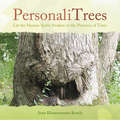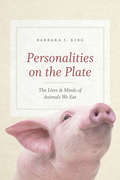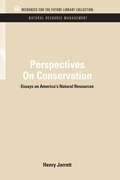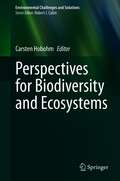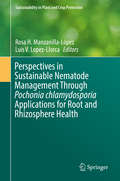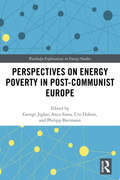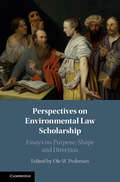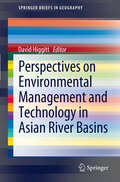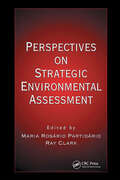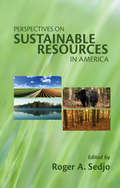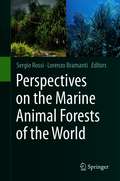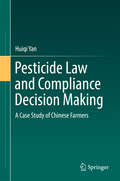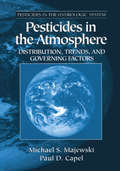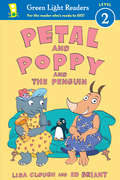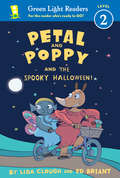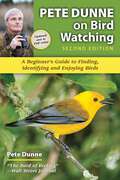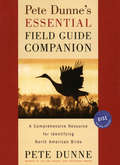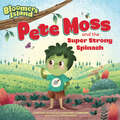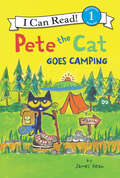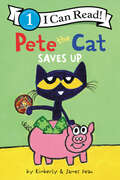- Table View
- List View
PersonaliTrees
by Joan Klostermann-KetelsBringing together photos of trees and inspirational quotes, this collection presents a new way of looking at trees. Trees can have visible faces, stories, beauty, loveliness, and hardship, and their personalities are brought to life in this book. Introducing trees as a portal to understanding the eternal truths and deeper meanings of life, the photographs and accompanying text inspire oneness with nature and illustrate how trees interact with all forms of life.
Personalities on the Plate: The Lives & Minds of Animals We Eat
by Barbara J. KingIn recent years, scientific advances in our understanding of animal minds have led to major changes in how we think about, and treat, animals in zoos and aquariums. The general public, it seems, is slowly coming to understand that animals like apes, elephants, and dolphins have not just brains, but complicated inner and social lives, and that we need to act accordingly. Yet that realization hasn’t yet made its presence felt to any great degree in our most intimate relationship with animals: at the dinner table. Sure, there are vegetarians and vegans all over, but at the same time, meat consumption is up, and meat remains a central part of the culinary and dining experience for the majority of people in the developed world. With Personalities on the Plate, Barbara King asks us to think hard about our meat eating--and how we might reduce it. But this isn’t a polemic intended to convert readers to veganism. What she is interested in is why we’ve not drawn food animals into our concern and just what we do know about the minds and lives of chickens, cows, octopuses, fish, and more. Rooted in the latest science, and built on a mix of firsthand experience (including entomophagy, which, yes, is what you think it is) and close engagement with the work of scientists, farmers, vets, and chefs, Personalities on the Plate is an unforgettable journey through the world of animals we eat. Knowing what we know--and what we may yet learn--what is the proper ethical stance toward eating meat? What are the consequences for the planet? How can we life an ethically and ecologically sound life through our food choices? We could have no better guide to these fascinatingly thorny questions than King, whose deep empathy embraces human and animal alike. Readers will be moved, provoked, and changed by this powerful book.
Perspectives On Conservation: Essays on America's Natural Resources (RFF Natural Resource Management Set)
by Henry JarrettA collection of papers based on those prepared by authorities who participated in the 1958 RFF forum, including contributions by Samuel Hays and John Kenneth Galbraith. Originally published in 1958
Perspectives for Biodiversity and Ecosystems (Environmental Challenges and Solutions)
by Carsten HobohmThe novelty of the book is a strong focus on perception, perspectives and prediction by scientists with profound insight into the ecology of ecosystems or into human demands and activity. The challenge is to bridge from empirical data and the knowledge of the past to the possibilities of the performance in the future. We assume that there is scope for more cooperation between the fields of ecology and practical philosophy or other social sciences in organising ecosystems and shaping the cultural future of humankind, and that such collaboration should be accorded considerably more priority. This book deals with environmental processes seen within a framework of the nature of ecosystems and human cultures. The future of the environment, the development of ecosystems and effective nature conservation management are the essentials of this book. Human nature and culture, and in particular their interactions, are interpreted as a set of rules and as given. The aim is not only to assess the significance of human influence on species composition and biodiversity but also to weigh up the subsequent potentials for action. In this book we will analyze the problems independently of one another, even if they are interconnected. This book focuses on perspectives and prognoses for the impacts of anthropogenic activity on ecosystems and thus on species conservation. Its goal is to improve assessments of the impacts of human activity on the environment. We are aware that prognoses have very often proven to be false. It is difficult to impossible to be able to predict with precision how evolution and ecosystems will change in future under anthropogenic influence. This strengthens our resolve to attempt to retain the highest possible degree of scientific integrity and professionalism and not to shy away from expressing the uncertainty of our own ideas and prognoses. We venture prognoses in this book and we will fail. However, we hope that we will be wrong on the right side.
Perspectives in Sustainable Nematode Management Through Pochonia chlamydosporia Applications for Root and Rhizosphere Health
by Rosa H. Manzanilla-López Luis V. Lopez-LlorcaThis volume reviews our current knowledge and novel research areas on Pochonia chlamydosporia, a cosmopolitan fungus occurring in soils as a saprophyte yet capable of colonizing the rhizosphere of crops as an endophyte and behaving as a parasite of eggs of plant-parasitic nematodes. The book is divided into six sections containing 18 chapters, starting with a historical background chapter, followed by 16 chapters, each contributed by experts, concerning those key aspects necessary to work with this biocontrol agent in a multidisciplinary treatise. Topics covered include systematics, biology, nematode-fungus interactions, nematode management strategies, secondary metabolites, and other methods including more novel research areas such as molecular, –omics, plant growth enhancement and endophytic abilities of P. chlamydosporia. The final chapter deals with the future perspectives of P. chlamydosporia research.
Perspectives on Energy Poverty in Post-Communist Europe (Routledge Explorations in Energy Studies)
by Anca Sinea George Jiglau Ute Dubois Philipp BiermannThis book explores the issue of energy poverty in post-communist Europe and shows how it is viewed and addressed through public policies. Energy poverty is severely affecting many parts of the European Union, but up until now only a few comparative analyses have been developed to understand the phenomenon and its diversity throughout the region. Filling this gap, this volume focuses specifically on the Eastern European region, drawing on contributions that cover a wide range of countries including Germany, Hungary, Poland, and Romania. This region has undergone significant transitions over the past three decades, but, as the contributions demonstrate, it still faces major challenges to providing clean and affordable energy to its citizens and renovating existing housing stock. The chapters explore the extent of energy poverty in each country and examine the drivers, while casting light on how policy-makers tackle the issue through a critical examination of the instruments implemented to help energy poor people. This book will be of great interest to researchers in the fields of energy policy and comparative politics, to policy-makers in post-communist countries and EU institutions, and also to other relevant actors, such as companies and NGOs who focus on issues of energy poverty.
Perspectives on Environmental Law Scholarship: Essays on Purpose, Shape and Direction
by Ole W. PedersenThis collection invites environmental law scholars to reflect on what it means to be an environmental law scholar and to consider how and why environmental law scholars engage in environmental law scholarship. Leading environmental law scholars from different backgrounds and jurisdictions offer their personal reflections on the nature, form, quality and challenges of environmental law scholarship. The collection offers the first honest introspection on what environmental law scholarship is and is not. It considers the unique contributions of environmental law scholarship to legal scholarship more generally, reflecting on what sets environmental law scholarship apart from other disciplines of legal scholarship and the challenges arising from these differences.
Perspectives on Environmental Management and Technology in Asian River Basins
by David HiggittAsian river basins are undergoing rapid transformation. This volume considers the implications of the environmental change-development nexus for water management, river health and hazard awareness. As Biswas and Tortajada (2011) have recently commented, water management in Asia will likely change more in the next twenty years than in the last 2000 years. Critical environmental trends include decreasing flows of water and sediment due to dam construction and increased water extraction, land use change (especially forest removal), encroachment and degradation of floodplain and wetland environments, increased water demand and concerns about water security, urban expansion and associated pollution of rivers and contamination of groundwater reserves. These challenges are being reframed by new approaches to water management which represent a transition from engineering-dominated approaches towards integrated water management, from technology transfer to adaptive technologies. The volume comprises an introduction and five chapters. Brierley and Callum reframe approaches to river repair within emerging theories of in ecology and earth science which regard nature as a complex adaptive system replete with inherent uncertainties. These ideas are mirrored in the four case study chapters which deal with water governance in the Mekong Basin (Hirsch); hybrid adoption of water resource technologies in India (Barbanente et al.); determination of sediment dynamics in Java Rijsdijk); and ecological conservation imperatives in the headwaters of the Yellow, Yangtze and Mekong rivers in western China (Li et al.).
Perspectives on Strategic Environmental Assessment
by Ray Clark Maria Rosário PartidárioAn environmental assessment must be performed whenever a property transaction takes place. Those who donít may find themselves responsible for the past misdeeds of others. This book contains contributions by professionals from various locations who use Strategic Environmental Assessment (SEA) as a tool applied to water management issues. SEA helps make decisions that increase sustainability. Because of its procedural nature, it necessarily becomes tailor-made to different applications. Easily understood and geographic in scope, this book presents leading edge thinking and first hand knowledge on the applications of SEA in water management.Perspectives on Strategic Environmental Assessment is a comprehensive guidebook for performing environmental assessments all over the world. No other source provides you with as much information on the applications of SEA as a policy assessment and management tool. This book provides a blueprint for environmental assessments that safeguards you from the oversights of others.
Perspectives on Sustainable Resources in America
by Roger A. SedjoThe vast size of the United States and extensive variation of its climate, topography, and biota across different regions contribute to both the richness of the nation?s natural heritage and the complexities involved in managing its resources. A follow-up to RFF?s popular America?s Renewable Resources (1990), Perspectives on Sustainable Resources in America updates readers about the current challenges involved in managing America?s natural resources, especially in light of the increasing emphasis on sustainability and ecosystem approaches to management. Written to inform general audiences and students, as well as to engage the interest of experts, the book includes assessments by some of the nation?s most renowned scholars in natural resource economics and policy. An introductory chapter critically examines the concept of sustainability as it has been developed in recent years and asks how the concept might apply to individual resource systems. It considers the interrelatedness of ecosystem, economic, and social sustainability; the paradigms of resource sufficiency and functional integrity; and the contrast between weak and strong sustainability. The chapters that follow examine America?s experience with forests, water, agricultural soils, and wildlife. Highlighting the adaptability and resilience of resource systems, each chapter provides a description of the physical characteristics of the resource, a history of its use, a policy history, and a review of ongoing debates in management and policy. Perspectives on Sustainable Resources in America concludes with an innovative treatment of biodiversity as a natural resource. The chapter reviews the definitions of biodiversity, the ecological and economic meanings of biodiversity, and current efforts to preserve biodiversity, especially through regulatory approaches.
Perspectives on the Marine Animal Forests of the World
by Sergio Rossi Lorenzo BramantiMarine Animal Forests (MAFs) are spread all over the world. Composed by suspension feeding organisms (e.g. corals, gorgonians, sponges, bryozoans, bivalves, etc.), MAFs constitute a vast number of marine ecosystems such as coral reefs, cold water corals, sponge grounds, bivalve beds, etc. The surface covered by these systems is prominent (at the scale of the oceans of the planet), though poorly known. In a previous book (Marine Animal Forests, the ecology of benthic biodiversity hotspots), several aspects of the MAFs were described and discussed, building the basis for a holistic approach with the aim of putting these shallow and deep sea ecosystems under a common umbrella. The main target of the present book is to identify and address important topics which were not covered in the previous three volumes. Bryozoans or Polychaeta, for example, are treated in this volume, as well as hydrothermal vents ecosystems and submarine caves, the chemical ecology in MAFs or the nursery effect on these ecosystems. The vastity of the MAF concept opens new insights in the biology, physiology, biodiversity of the organisms structuring these highly biodiverse ecosystems and on the dangers threatening them (such as microplastics or the role of invasive species as an impact of their trophic ecology or distribution). In a fast changing world, in which the complexity of MAFs is at risk, we propose an in-depth analysis of many aspects that may be inspirational for future research lines in marine biology and ecology.
Pesticide Law and Compliance Decision Making
by Huiqi YanThis book investigates pesticide compliance in China in order to provide a more comprehensive understanding of compliance and offers some feasible and adaptable suggestions for enhancing the effectiveness of this compliance. It discusses the weak implementation of Chinese laws and rules and emphasizes the necessity and importance of a compliance perspective in China that focuses on why laws are obeyed or broken. It examines how vegetable farmers' perceptions of amoral calculation affect their pesticide compliance behavior and analyzes how the legitimacy of law is related to compliance to better explain how all the variables interact to shape compliance. It discusses both qualitative and quantitative methods, and uses a large-N qualitative approach, which allows for systematic analysis and in-depth exploration. This book will help readers to understand compliance in developing China by adopting and developing compliance theories which are broadly developed in the West.
Pesticides in the Atmosphere: Distribution, Trends, and Governing Factors
by Michael S. MajewskiMost people know about the presence and health effects of pesticide residues in the water they drink. However, they may not realize the impact of atmospheric transportation and deposition of pesticides on water quality. Scientific studies of pesticides in various atmospheric matrices (air, rain, snow, aerosols, and fog) provide some of the answers.
Pests of Landscape Trees and Shrubs (Second Edition)
by Steve H. Dreistadt Jack Kelly Clark Mary Louise FlintThis is the ultimate guide to managing landscape pests! With this manual in hand you will be able to diagnose and manage hundreds of insect, mite, weed, plant disease, and nematode pests. Inside you'll find updated information on how to use environmentally safe, ecologically based IPM methods; landscape designs that prevent pests; how to select resistant varieties; advice on the use of less-toxic pesticides such as botanicals, oils, and soaps; and tips on planting, irrigating, and other plant-care cultural activities that help in avoiding problems. Contains over one hundred pages of easy-to-use tree and shrub pest tables; invaluable in helping you identify common pest problems now on over 200 types of ornamental trees and shrubs. Includes 432 color photographs, 117 drawings and tables, references, glossary, and an index.
Pests: How Humans Create Animal Villains
by Bethany BrookshireAn engrossing and revealing study of why we deem certain animals “pests” and others not—from cats to rats, elephants to pigeons—and what this tells us about our own perceptions, beliefs, and actions, as well as our place in the natural worldA squirrel in the garden. A rat in the wall. A pigeon on the street. Humans have spent so much of our history drawing a hard line between human spaces and wild places. When animals pop up where we don’t expect or want them, we respond with fear, rage, or simple annoyance. It’s no longer an animal. It’s a pest.At the intersection of science, history, and narrative journalism, Pests is not a simple call to look closer at our urban ecosystem. It’s not a natural history of the animals we hate. Instead, this book is about us. It’s about what calling an animal a pest says about people, how we live, and what we want. It’s a story about human nature, and how we categorize the animals in our midst, including bears and coyotes, sparrows and snakes. Pet or pest? In many cases, it’s entirely a question of perspective.Bethany Brookshire’s deeply researched and entirely entertaining book will show readers what there is to venerate in vermin, and help them appreciate how these animals have clawed their way to success as we did everything we could to ensure their failure. In the process, we will learn how the pests that annoy us tell us far more about humanity than they do about the animals themselves.
Pet Parrots (Nature's Children)
by Frank PuccioWhat can compare with the sight of a large, beautiful bird flying through the air or landing--brightly colored wings stretched out--on a branch? Birds, with their colors and flight, have fascinated people for thousands of years. The ancient Egyptians had gods who were birds. The ancientGreeks told tales of daredevils who tried to add wings and feathers to their bodies. And for hundreds of years inventors of all nations worked to create machines that would allow humans to fly like the birds. Of all the birds of the world few are as colorful and as fascinating as parrots. Beautiful, affectionate, and full of individual personality, they even are clever enough to talk. It's no wonder that for hundreds of years they have been among the world's most treasured pets and companions.
Petal and Poppy and the Penguin (Green Light Readers Level 2)
by Ed Briant Lisa CloughPetal and Poppy discover an uninvited visitor in their garden—a penguin! At first, Petal's too afraid to let him in. But eventually not even Petal can resist this cute, friendly, and very talented little guy! Petal and Poppy and the Penguin is the second Petal and Poppy book, told in graphic form. Word repetition, picture clues, and a simple plotline facilitate young readers in their development into lifelong lovers of reading.
Petal and Poppy and the Spooky Halloween! (Green Light Readers Level 2)
by Ed Briant Lisa CloughHalloween is here and Petal and Poppy are going to a party! But Petal's scared. Halloween is too spooky. But Poppy assures Petal it's all just pretend. There's nothing to be afraid of. But then a haunted house scares Poppy. Maybe Halloween is a little spooky after all! The writing level and picture clues will help early readers perfect their reading technique, while the wonderful story--with just the right amount of spookiness--will spark a love of reading that will last a lifetime.
Petcam
by Chris KeeneyAs close as we are to our beloved pets, we often wonder how they spend their days when we aren't watching. What do they explore? How does the world look from the point of view of our dogs and cats--or our chickens and goats? PetCam, by photographer Chris Keeney, author of Pinhole Cameras, presents a collection of striking and amusing images created by an international roster of four-legged photographers. With small, lightweight cameras attached to their collars and cowbells, they document what they see as they go about their daily routines--lounging under parked cars, scaling rooftops, jumping fences, relaxing in a neighbor's tall grass. You'll see the world through the eyes of more than twenty intrepid pets, including Coulee, a Border Collie-Golden Retriever mix from Alberta, Canada; Fritz, a tabby cat living in the Ore Mountains of Germany; Walter and Hamlet, brother and sister miniature pot belly pigs from San Diego; and Sofie, a Galloway cow, who spends her days roaming the hills of the Swiss Alps. This unique and whimsical collection offers a peek into the wanderings of our animal friends, and reveals how they experience the world we all share.
Pete Dunne on Bird Watching
by Pete DunneBirding is one of the most popular and fastest-growing outdoor activities, but it can seem intimidating for beginners who don't know where, when, or how to search for birds. Fortunately, Pete Dunne, one of the most popular and respected writers in the field, has written a guide that will help even the most casual observers identify the skills and tools they need to develop their interest in birding.
Pete Dunne's Essential Field Guide Companion: A Comprehensive Resource for Identifying North American Birds
by Pete DunneFrom the award-winning birder and author of Birds of Prey, an authoritative, information-packed guide to distinguishing North American birds.In this book, bursting with more information than any field guide could hold, the well-known author and birder Pete Dunne introduces readers to the &“Cape May School of Birding.&” It's an approach to identification that gives equal or more weight to a bird's structure and shape and the observer's overall impression (often called GISS, for General Impression of Size and Shape) than to specific field marks. After determining the most likely possibilities by considering such factors as habitat and season, the birder uses characteristics such as size, shape, color, behavior, flight pattern, and vocalizations to identify a bird. The book provides an arsenal of additional hints and helpful clues to guide a birder when, even after a review of a field guide, the identification still hangs in the balance. This supplement to field guides shares the knowledge and skills that expert birders bring to identification challenges. Birding should be an enjoyable pursuit for beginners and experts alike, and Pete Dunne combines a unique playfulness with the work of identification. Readers will delight in his nicknames for birds, from the Grinning Loon and Clearly the Bathtub Duck to Bronx Petrel and Chicken Garnished with a Slice of Mango and a Dollop of Raspberry Sherbet.
Pete Moss and the Super Strong Spinach: Bloomers Island Garden of Stories #1 (Bloomers Island #1)
by Courtney Carbone Cynthia WylieFollow Pete Moss in this magical, beautifully illustrated story as he attends boarding school on Bloomers Island to learn about gardening and growing his own vegetables. When Professor Sage announces the Very Very Veggie Challenge, Pete immediately knows what he needs to grow spinach. It&’s the one vegetable that can make him stronger. But does Pete have the patience to grow his spinach plants to win the contest? With the help of headmaster Professor Sage and his fellow Bloomers, Pete learns all about spinach, working hard toward his goals, and that good things take time to happen!The Bloomers Isalnd series brings to life the world of gardening and healthy-eating to young children in new and exciting ways.
Pete the Cat Falling for Autumn (Pete the Cat)
by Kimberly Dean James DeanNew York Times bestselling creators James and Kimberly Dean show us all the wonderful things about autumn. A great book to share with the family at Thanksgiving or anytime!Pete the Cat isn't sure about the changing of the seasons from summer to autumn. But when he discovers corn mazes, hay rides, and apple picking, Pete realizes there's so much to enjoy and be thankful for about autumn.
Pete the Cat Goes Camping (I Can Read Level 1)
by Kimberly Dean James DeanNew York Times bestselling author and artist James Dean takes readers along for an outdoor adventure with Pete the Cat!In Pete the Cat Goes Camping, Pete can't wait to go hiking, fishing, and eat s'mores by the campfire. But when he hears about the mysterious creature named Bigfoot, Pete can't help but wonder: Is Bigfoot real?Kids love exploring the outdoors, and they're sure to enjoy this funny story about Pete the Cat going camping for the first time (and overcoming his small fears).Pete the Cat Goes Camping is a Level One I Can Read book, which means it’s perfect for children learning to sound out words and sentences. Whether shared at home or in a classroom, the short sentences, familiar words, and simple concepts of Level One books support success for children eager to start reading on their own.
Pete the Cat Saves Up (I Can Read Level 1)
by Kimberly Dean James DeanPete the Cat earns and saves money to buy a supercool toy in this Level 1 I Can Read from New York Times bestselling creators Kimberly and James Dean.Pete the Cat wants a supercool Sharkbot toy, but he doesn’t have enough money in his piggy bank. He takes on odd jobs, from shoveling snow to selling lemonade and more, and saves every penny. How long will it take for him to earn enough money to buy the toy? Find out in this Level 1 I Can Read book complete with original illustrations from the creators of Pete the Cat, Kimberly and James Dean. Pete the Cat Saves Up is perfect for children learning to sound out words and sentences. Whether shared at home or in a classroom, the short sentences, familiar words, and simple concepts of Level One books support success for children eager to start reading on their own.
